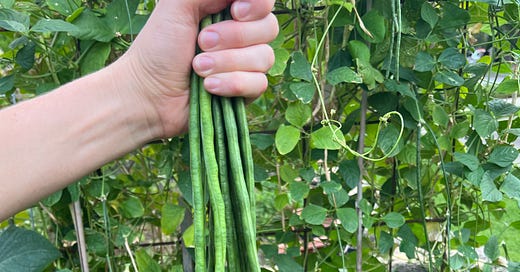The perfect spring veggie garden: a recipe
Djilba has arrived. Spring is on the wing and it's time to grow an easy peasy salad garden!
Welcome to Lo fi life, a cheerfully unsophisticated newsletter about gardening, cooking and things that are good. Not subscribed yet? Click the button:
Notes:
Today’s full newsletter is only available to paid subscribers.
It’s a simple planting ‘recipe’ for an easy edible garden (which you can plant in one square meter of space) that will give you fresh and delicious salads through spring and into summer!
If you’d like to read the full newsletter (and to access all of my member-only guides, newsletters, recipes and videos), consider becoming a paying member of Lo fi Life, or upgrading your subscription and becoming a member of my Wild Garden club (you can do this by clicking the button below).
Hello! Let’s get straight down to business. It is August you may very well think that means it’s still winter and you have permission to sit inside and watch the rain pour down and drink cups of tea and daydream about your spring garden. But that is wrong wrong WRONG!
There is no time for daydreaming in this life! It is AUGUST and there is only time for wild and manic seed sowing.
We have developed a bad habit in Australia of setting our clocks by the English seasons, and year after year it leads us all astray. We think winter is the time to hibernate and that we don’t need to be thinking about or doing anything in our gardens until September rolls around. But… have you looked outside lately? Have you noticed what’s actually going on? Blossoms are blossoming, buds are bursting! And once again I am reminded that Western Australia doesn’t really have four seasons, but six.
The Noongar seasons are, unsurprisingly, a much better description of the actual weather we encounter in WA, and Djilba - the explosive season of plant growth and blooms - has just begun. Djilba runs from August to September and it probably the best, most exciting and most rewarding time to get out into your garden and throw plants into the soil.
(I mean, if you ask me every day of the calendar year is a good time to be throwing plants into your soil. But if you haven’t been doing it yet, now is the time to get on it. And I have the plants for you!)
Garden recipes: the Djilba edition
This could easily become an endlessly sprawling list because there are SO many things you could be growing right this minute. Instead of overwhelming you with plant ideas, today I want to give you one garden recipe.
Just like recipes in cookbooks give you a list of ingredients and a method to combine them for success, I’m going to give you a garden recipe with plants to grow and instructions on how to combine them for a delicious spring garden.
Today’s recipe is for a super easy edible garden, one that you can use to create fresh salads throughout spring and into summer.
A simple recipe for an easy edible garden
A lot of edible plants are way more fussy and prone to problems than ornamental plants. This is why it always worries me when people’s first attempt at gardening is growing a giant veggie patch. It’s romantic, sure, but it’s the most likely way for a beginner to (mistakenly) think they’re a brown thumb, that gardening is impossible, and that they should just give up.
Not all edibles are created equal, though, and some are devastatingly easy and useful. In my opinion, the best edibles to grow fulfil one (or more) of these requirements:
a) they have long harvest windows
b) they can be harvested a little at a time
c) you can eat many parts of the plant across its life cycle
Today’s recipe contains plants that fulfil one or more of these requirements, making them truly versatile and useful in your garden. They also combine brilliantly in a spring salad (more on that in a mo).
Note: you need good soil to grow edibles successfully, even the easy ones. If you haven’t already watched it, check out my guide to soil improvement here.
Materials
1m x 1m garden bed (obviously a bigger garden is better, but all of these plants can grow in a tight space, if you need them to.
A wire frame (reo mesh or chicken wire is ideal) 1m wide and 2m tall
Ingredients
Snake beans (seeds)
If you’re working with a 1m x 1m bed you’ll only need about 5-10 snake bean seeds (honestly probably even fewer, but I always over-plant my beds). Snake beans are a MUST for your spring/summer garden - they are my absolute favourite legume to grow for flavour, they always perform (don’t stress out if yours look a bit sad initially, I find they sometimes have an awkward ‘teenage’ growth period, but I just leave them alone and once the weather gets worm they always hit their stride) and they have a looooooong harvest window.
If you make sure to keep picking the beans these will keep you in beans all summer. At the end of the season, leave some beans to dry on the vine and you’ll have seeds to sow next spring. These beans are also called ‘footlong’ beans because they grow so long and snakey - they are fantastic. Grow them! (you can buy some locally here)
Keep reading with a 7-day free trial
Subscribe to lofi life to keep reading this post and get 7 days of free access to the full post archives.





